Keyword: Microcystin
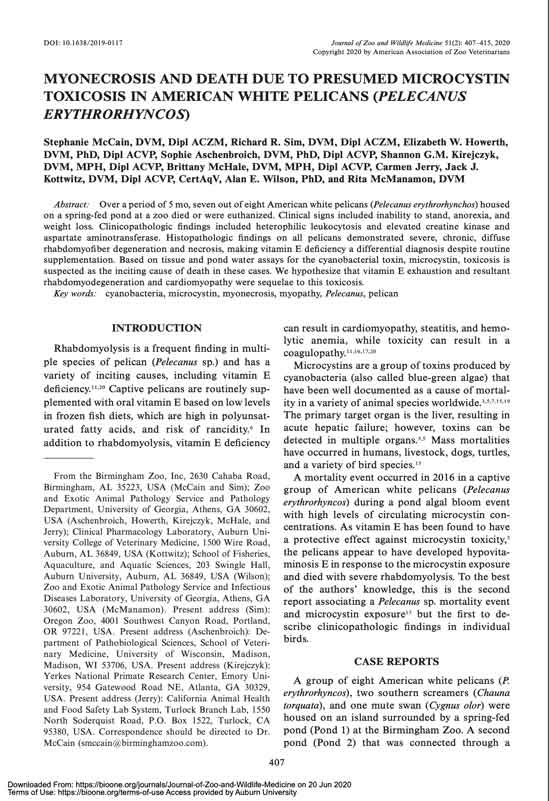
McCain, S., R. R. Sim, E. W. Howerth, S. Aschenbroich, S. G.M. Kirejczyk, B. McHale, C. Jerry, J. J. Kottwitz, A. E. Wilson, and R. McManamon. 2020. Myonecrosis and death due to presumed microcystin toxicosis in American white pelicans (Pelecanus erythrorhyncos). Journal of Zoo and Wildlife Medicine 51(2):407-415.
Abstract
Over a period of 5 mo, seven out of eight American white pelicans (Pelecanus erythrorhynchos) housed on a spring-fed pond at a zoo died or were euthanized. Clinical signs included inability to stand, anorexia, and weight loss. Clinicopathologic findings included heterophilic leukocytosis and elevated creatine kinase and aspartate aminotransferase. Histopathologic findings on all pelicans demonstrated severe, chronic, diffuse rhabdomyofiber degeneration and necrosis, making vitamin E deficiency a differential diagnosis despite routine supplementation. Based on tissue and pond water assays for the cyanobacterial toxin, microcystin, toxicosis is suspected as the inciting cause of death in these cases. We hypothesize that vitamin E exhaustion and resultant rhabdomyodegeneration and cardiomyopathy were sequelae to this toxicosis.
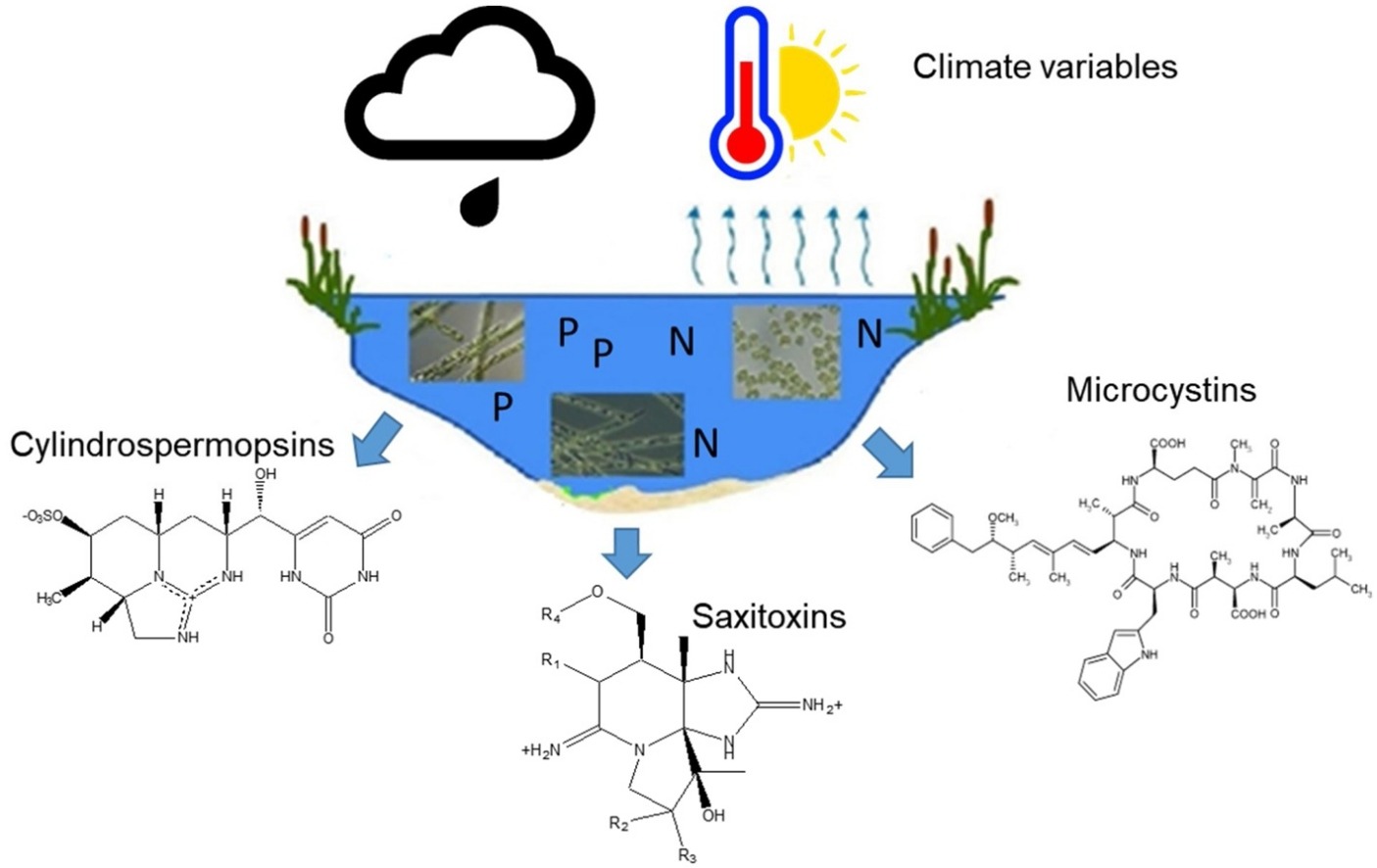
Barros, M. U. G., A. E. Wilson, J. I. R. Leitão, S. P. Pereira, R. P. Buley, E. G. Fernandez-Figueroa, and J. Capelo-Neto. 2019. Environmental factors associated with toxic cyanobacterial blooms across 20 drinking water reservoirs in a semi-arid region of Brazil. Harmful Algae 86:128-137.
Abstract
Cyanobacteria are known to produce a wide variety of bioactive, toxic secondary metabolites generally described as hepatotoxins, neurotoxins, cytotoxins, or dermatoxins. In Brazil, the regular monitoring of cyanobacterial toxins has intensified after the death of 65 patients in a hemodialysis clinic in Caruaru in the state of Pernambuco due to microcystin exposure. The primary objective of this study was to use multivariate statistics that incorporated environmental parameters (both biotic and abiotic) to forecast blooms of cyanobacteria and their toxic secondary metabolites in 20 drinking water reservoirs managed by the Water Treatment Company of Ceará (CAGECE) in the semi-arid region of Ceará, Brazil. Across four years (January 2013 to January 2017), 114 different phytoplankton taxa were identified, including 24 cyanobacterial taxa. In general, Ceará reservoirs were dominated by cyanobacteria due to eutrophication but also because of the dry and warm climate found throughout the region. Interestingly, specific cyanobacterial taxa were influenced by different biotic and abiotic factors. For example, nitrogen-to-phosphorus (N:P) and evaporation were positively related to saxitoxin-producing taxa, especially Raphidiopsis raciborskii, while temperature, electrical conductivity, total phosphorus, and transparency (measured as Secchi depth) were positively associated with microcystin-producing taxa, such as Microcystis aeruginosa. Climate forecasts predict higher evaporation and temperatures in the semi-arid Ceará region, which will likely magnify droughts and water scarcity as well as promote toxic cyanobacterial blooms in reservoirs in the future. Therefore, understanding the factors associated with algal blooms dominated by specific taxa is paramount for water resource management.
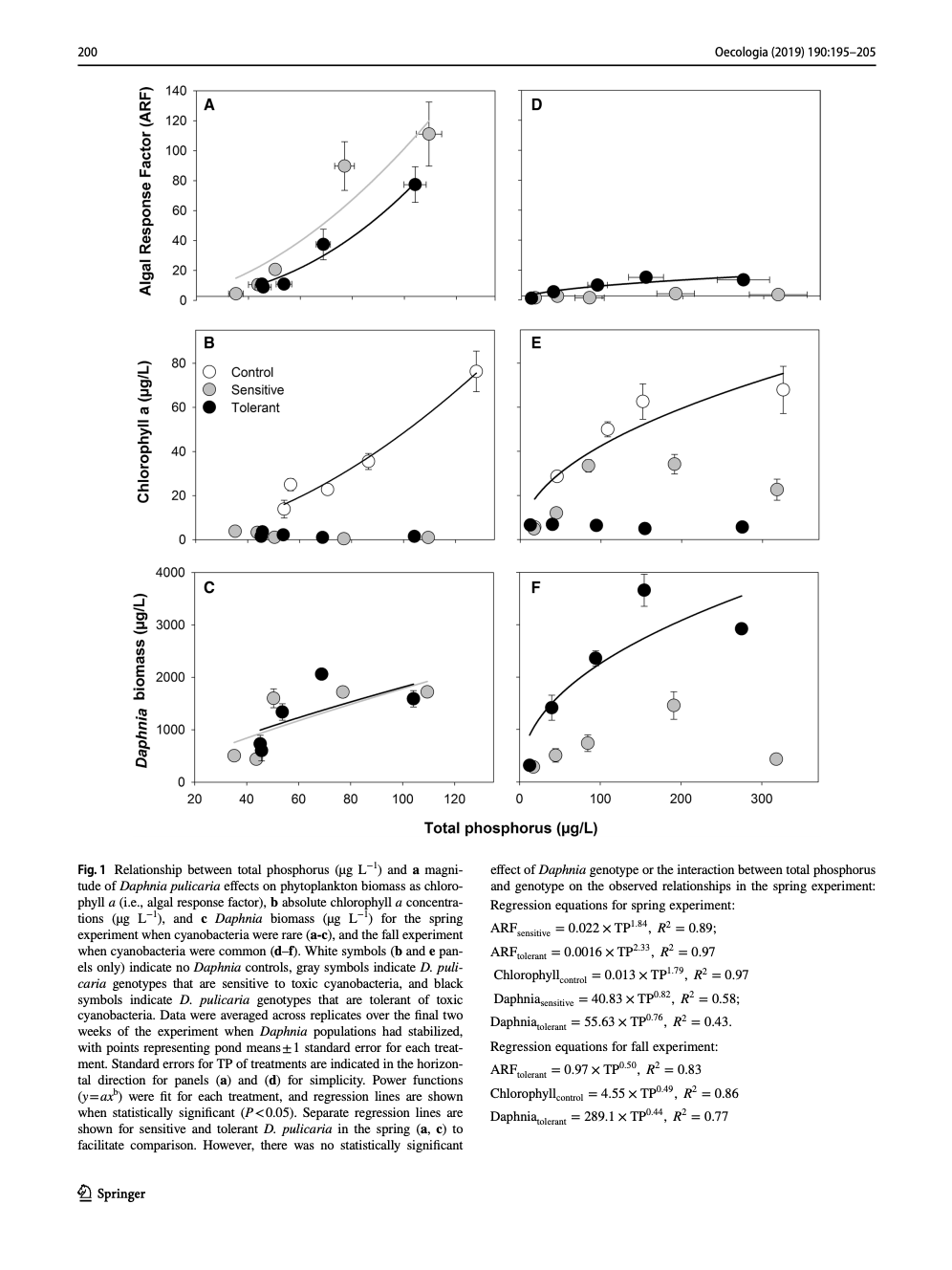
Chislock, M. F., O. Sarnelle, L. M. Jernigan, V. R. Anderson, A. Abebe, and A. E. Wilson. 2019. Consumer adaptation mediates top-down regulation across a productivity gradient. Oecologia 190:195-205.
Abstract
Humans have artificially enhanced the productivity of terrestrial and aquatic ecosystems on a global scale by increasing nutrient loading. While the consequences of eutrophication are well known (e.g., harmful algal blooms and toxic cyanobacteria), most studies tend to examine short-term responses relative to the time scales of heritable adaptive change. Thus, the potential role of adaptation by organisms in stabilizing the response of ecological systems to such perturbations is largely unknown. We tested the hypothesis that adaptation by a generalist consumer (Daphnia pulicaria) to toxic prey (cyanobacteria) mediates the response of plankton communities to nutrient enrichment. Overall, the strength of Daphnia’s top–down effect on primary producer biomass increased with productivity. However, these effects were contingent on prey traits (e.g., rare vs. common toxic cyanobacteria) and consumer genotype (i.e., tolerant vs sensitive to toxic cyanobacteria). Tolerant Daphnia strongly suppressed toxic cyanobacteria in nutrient-rich ponds, but sensitive Daphnia did not. In contrast, both tolerant and sensitive Daphnia genotypes had comparable effects on producer biomass when toxic cyanobacteria were absent. Our results demonstrate that organismal adaptation is critical for understanding and predicting ecosystem-level consequences of anthropogenic environmental perturbations.
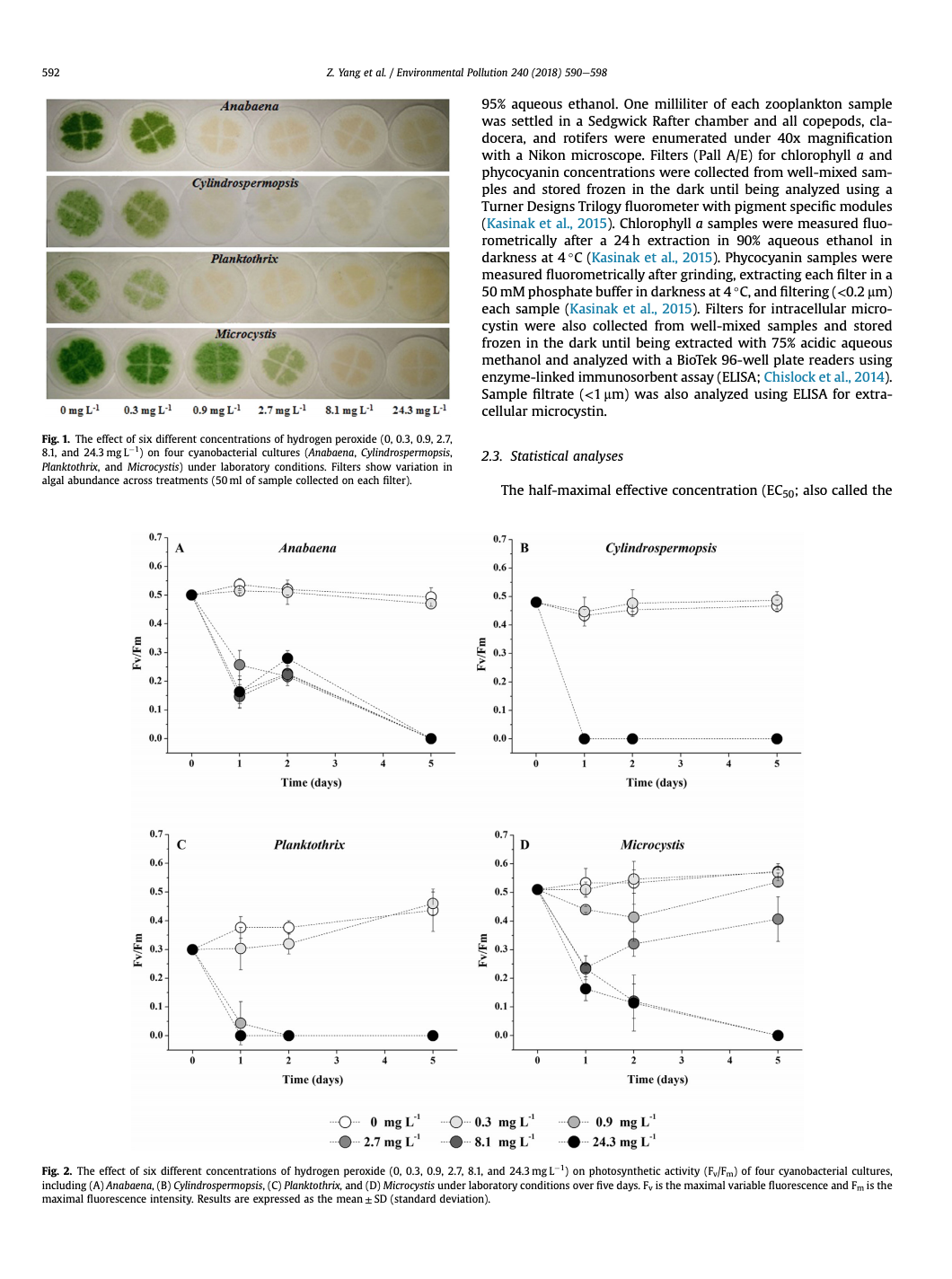
Yang, Z., R. P. Buley, E. G. Fernandez-Figueroa, M. U.G. Barros, S. Rajendran, and A. E. Wilson. 2018. Hydrogen peroxide treatment promotes chlorophytes over toxic cyanobacteria in a hyper-eutrophic aquaculture pond. Environmental Pollution 240:590-598.
Abstract
Controlling blooms of toxigenic phytoplankton, including cyanobacteria, is a high priority for managers of aquatic systems that are used for drinking water, recreation, and aquaculture production. Although a variety of treatment approaches exist, hydrogen peroxide (H2O2) has the potential to be an effective and ecofriendly algaecide given that this compound may select against cyanobacteria while not producing harmful residues. To broadly evaluate the effectiveness of H2O2 on toxigenic phytoplankton, we tested multiple concentrations of H2O2 on (1) four cyanobacterial cultures, including filamentous Anabaena, Cylindrospermopsis, and Planktothrix, and unicellular Microcystis, in a 5-day laboratory experiment and (2) a dense cyanobacterial bloom in a 7-day field experiment conducted in a nutrient-rich aquaculture pond. In the laboratory experiment, half-maximal effective concentrations (EC50) were similar for Anabaena, Cylindrospermopsis, and Planktothrix (average EC50 = 0.41 mg L-1) but were ∼10x lower than observed for Microcystis (EC50 = 5.06 mg L-1). Results from a field experiment in an aquaculture pond showed that ≥1.3 and ≥ 6.7 mg L-1 of H2O2 effectively eliminated Planktothrix and Microcystis, respectively. Moreover, 6.7 mg L-1 of H2O2 reduced microcystin and enhanced phytoplankton diversity, while causing relatively small negative effects on zooplankton abundance. In contrast, 20 mg L-1 of H2O2 showed the greatest negative effect on zooplankton. Our results demonstrate that H2O2 can be an effective, rapid algaecide for controlling toxigenic cyanobacteria when properly dosed.
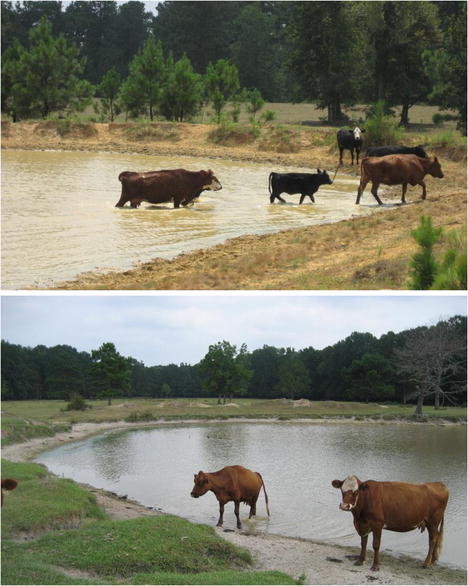
Wilson, A. E., M. F. Chislock, Z. Yang, M. U.G. Barros, and J. F. Roberts. 2018. Pond bank access as an approach for managing toxic cyanobacteria in beef cattle pasture drinking water ponds. Environmental Monitoring and Assessment 190:247.
Abstract
Forty-one livestock drinking water ponds in Alabama beef cattle pastures during were surveyed during the late summer to generally understand water quality patterns in these important water resources. Since livestock drinking water ponds are prone to excess nutrients that typically lead to eutrophication, which can promote blooms of toxigenic phytoplankton such as cyanobacteria, we also assessed the threat of exposure to the hepatotoxin, microcystin. Eighty percent of the ponds studied contained measurable microcystin, while three of these ponds had concentrations above human drinking water thresholds set by the US Environmental Protection Agency (i.e., 0.3 μg/L). Water quality patterns in the livestock drinking water ponds contrasted sharply with patterns typically observed for temperate freshwater lakes and reservoirs. Namely, we found several non-linear relationships between phytoplankton abundance (measured as chlorophyll) and nutrients or total suspended solids. Livestock had direct access to all the study ponds. Consequently, the proportion of inorganic suspended solids (e.g., sediment) increased with higher concentrations of total suspended solids, which underlies these patterns. Unimodal relationships were also observed between microcystin and phytoplankton abundance or nutrients. Euglenoids were abundant in the four ponds with chlorophyll concentrations > 250 μg/L (and dominated three of these ponds), which could explain why ponds with high chlorophyll concentrations would have low microcystin concentrations. Based on observations made during sampling events and available water quality data, livestock-mediated bioturbation is causing elevated total suspended solids that lead to reduced phytoplankton abundance and microcystin despite high concentrations of nutrients, such as phosphorus and nitrogen. Thus, livestock could be used to manage algal blooms, including toxic secondary metabolites, in their drinking water ponds by allowing them to walk in the ponds to increase turbidity.
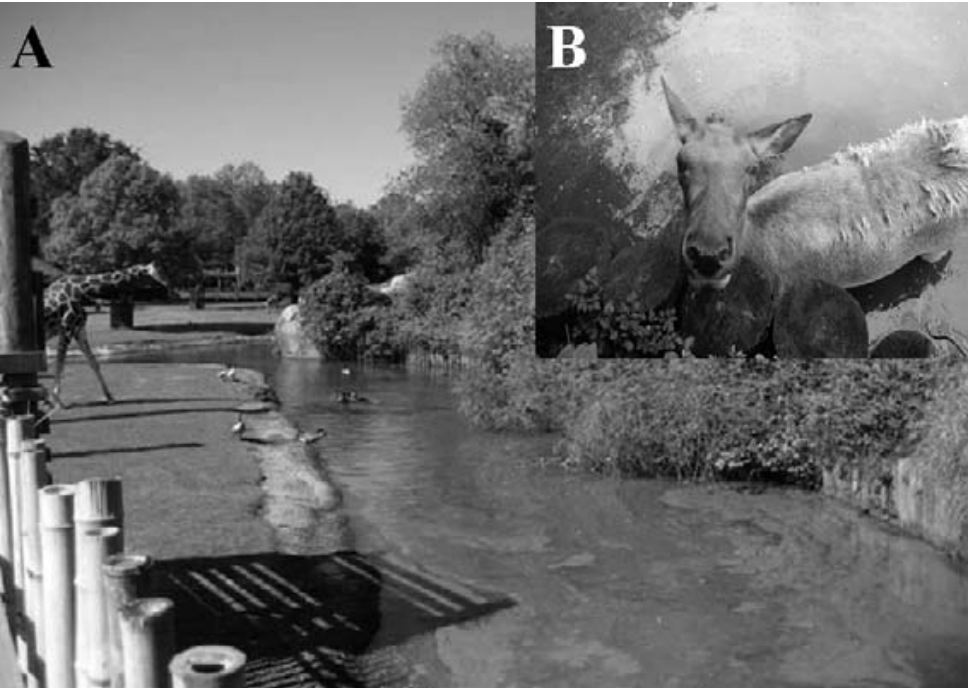
Doster, E., M. F. Chislock, J. F. Roberts, J. J. Kottwitz, and A. E. Wilson. 2014. Recognition of an important water quality issue at zoos: prevalence and potential threat of toxic cyanobacteria. Journal of Zoo and Wildlife Medicine 45(1):165-168.
Abstract
Zoo animals may be particularly vulnerable to water sources contaminated with cyanobacterial toxins given their nonvoluntary close association with this resource. However, the prevalence and potential threat of toxic cyanobacteria in this setting are unknown. Several otherwise unexplained yellow-bellied slider (Trachemys scripta scripta) deaths were documented in a zoo moat with recurring blooms of toxic Microcystis aeruginosa. Furthermore, an extremely high and potentially lethal concentration of the hepatotoxin microcystin (166 ng/g) was found in the liver of a necropsied turtle that died in this moat. A subsequent monthly survey of water quality revealed detectable concentrations of microcystin in all moats (0.0001 to 7.5 μg/L), with moats higher than 1 μg/L being significantly higher than the threshold for safe drinking water recommended by the World Health Organization. These results demonstrate that cyanobacterial blooms are an important water quality issue in zoos, and future research is necessary to identify potential associations among water quality, zoo animal health, and moat management strategies.
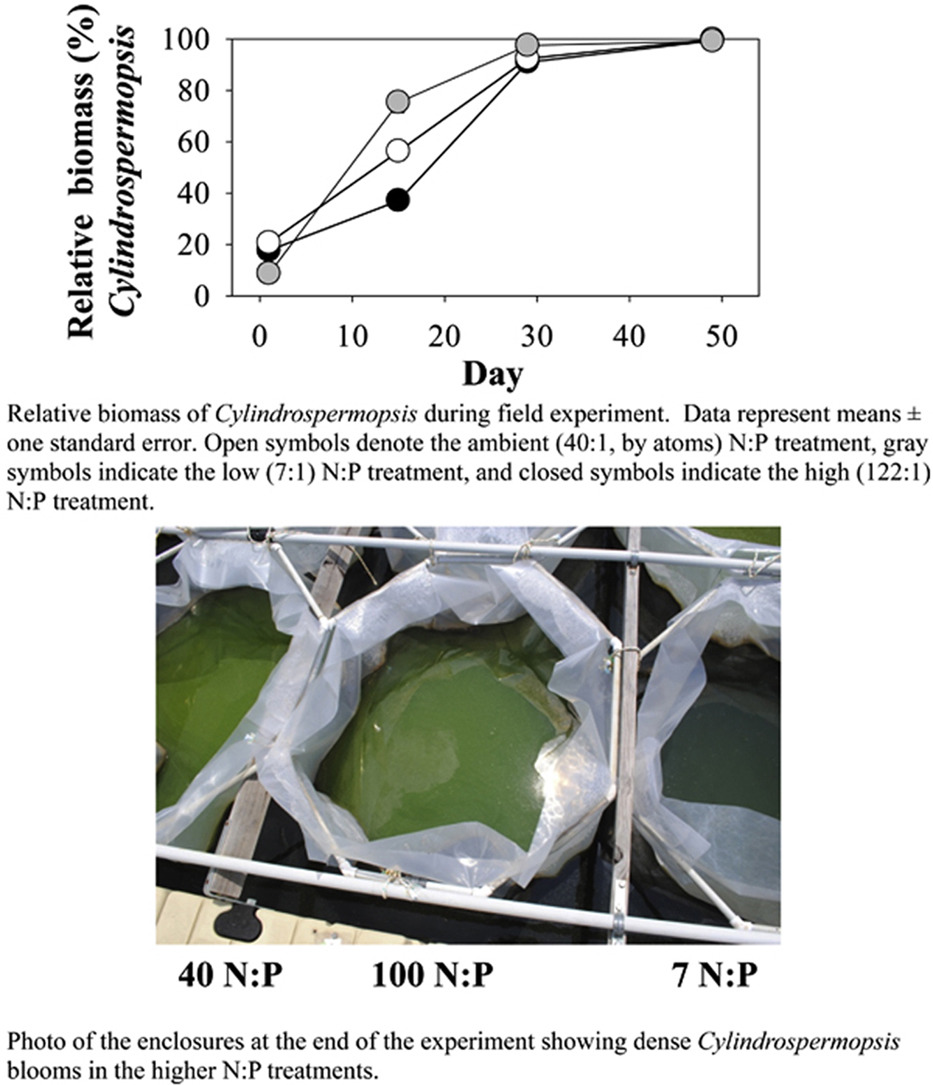
Chislock, M. F., K. L. Sharp, and A. E. Wilson. 2014. Cylindrospermopsis raciborskii dominates under very low and high nitrogen-to-phosphorus ratios. Water Research 49:207-214.
Abstract
In freshwater ecosystems, a variety of factors mediate phytoplankton community structure, including herbivore community structure, light availability, temperature, mixing, and absolute and relative nutrient concentrations (total nitrogen (TN), total phosphorus (TP)). Ecological stoichiometry examines how the nutrient content of organisms and their environment may mediate population-, community-, and ecosystem-level processes. The manipulation of N:P ratios is a widely regarded tool for managing phytoplankton species composition given that nitrogen-fixing cyanobacteria should dominate algal communities under relatively low N:P (<64:1, by atoms) given their ability to convert dissolved dinitrogen gas into organic nitrogen. However, due to the physiological expense of nitrogen fixation, diazotrophs should be outcompeted by non-nitrogen fixing phytoplankton under higher N:P when other environmental factors are similar. We tested this hypothesis in a field experiment using 2500-L limnocorrals installed in a eutrophic lake (ambient N:P ∼40:1 (by atoms); TN ∼1360 μg L−1; TP ∼75 μg L−1). At the start of the experiment, we randomly assigned limnocorrals among the ambient (40:1) and low (7:1) or high (122:1) N:P treatments (n = 4 replicates/treatment), which were established by adding P or N at the start of the experiment, respectively. The phytoplankton community in the enclosures at the start of the experiment was diverse (i.e., 18 phytoplankton genera) and dominated by chlorophytes (including Coelastrum and Scenedesmus (30% and 13% of total biomass, respectively)) and cyanobacteria (including Anabaena and Cylindrospermopsis (23% and 17% of total biomass, respectively)). In contrast to predictions based on ecological stoichiometry, the phytoplankton community in all N:P treatments increased in abundance and was almost entirely composed of the nitrogen-fixing cyanobacterium, Cylindrospermopsis raciborskii, by the conclusion of the study. Moreover, concentrations of the cyanobacterial neurotoxin, saxitoxin, were enhanced under the two highest N:P conditions. The ability of C. raciborskii to dominate phytoplankton communities under such extreme N:P shows that short-term management of nutrient stoichiometry through fertilization is not likely to be effective for controlling blooms of this noxious cyanobacterium and may help to explain the rapid expansion of this invasive species to temperate latitudes.
Knoll, L. B., O. Sarnelle, S. K. Hamilton, C. E. H. Kissman, A. E. Wilson, J. B. Rose, and M. R. Morgan. 2008. Invasive zebra mussels (Dreissena polymorpha) increase cyanobacterial toxin concentrations in low-nutrient lakes. Canadian Journal of Fisheries and Aquatic Sciences 65(3):448-455.
Abstract
We investigated whether concentrations of the cyanobacterial toxin microcystin were positively associated with Dreissena polymorpha invasion by conducting surveys of 39 inland lakes in southern Michigan with low to moderate total phosphorus concentrations (≤20 μg·L-1). Lakes with D. polymorpha had 3.3 times higher microcystin concentrations and 3.6 times higher biomass of Microcystis aeruginosa (a major producer of microcystin) than comparable lakes without D. polymorpha. In contrast, the biomass of Anabaena spp. (another potential producer of microcystin) was 4.6 times higher in lakes without D. polymorpha. We also conducted a large-scale enclosure manipulation of D. polymorpha density in Gull Lake, a low-nutrient lake containing D. polymorpha. The experiment revealed a positive effect of D. polymorpha on microcystin concentrations and M. aeruginosa biomass. The congruence between survey and experimental results provides strong evidence that D. polymorpha invasion causes an increase in toxin concentrations in lakes with low to moderate nutrients. An increase in M. aeruginosa biomass may negatively impact food webs and public health because microcystins are known to be toxic to aquatic and terrestrial organisms.
Wilson, A. E., D. C. Gossiaux, T. O. Höök, J. P. Berry, P. F. Landrum, J. Dyble, and S. J. Guildford. 2008. Evaluation of the human health threat associated with the hepatotoxin, microcystin, in the muscle and liver tissues of yellow perch (Perca flavescens). Canadian Journal of Fisheries and Aquatic Sciences 65(7):1487-1497.
Abstract
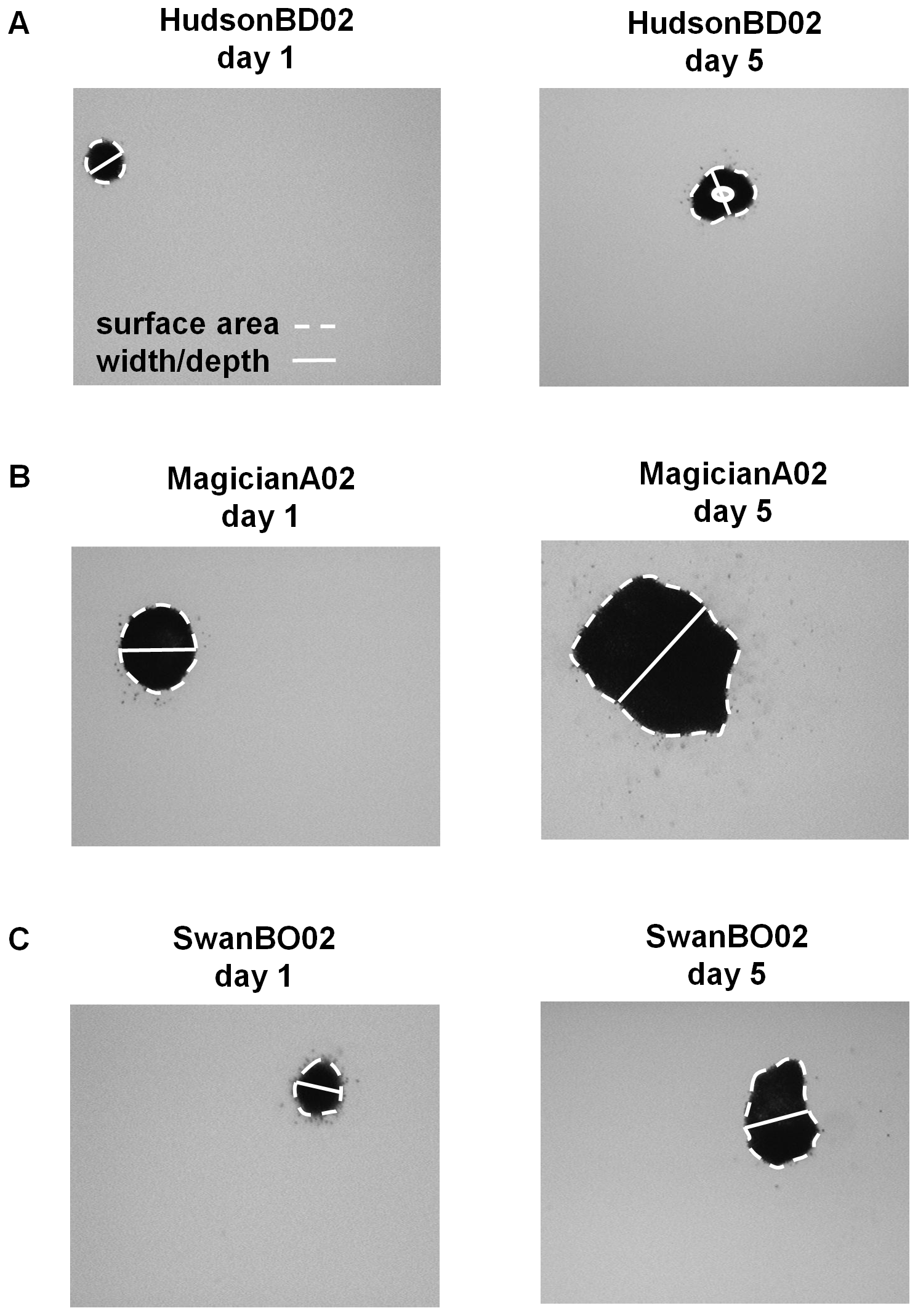
Wilson, A. E. and M. E. Hay. 2007. A direct test of cyanobacterial chemical defense: Variable effects of microcystin-treated food on two Daphnia pulicaria clones. Limnology and Oceanography 52(4):1467-1479.
Abstract
To determine the direct effects of microcystin on the fitness of herbivorous zooplankton, we experimentally added microcystin-LR to freeze-dried cells of palatable Chlorella and fed these compound-treated cells to two clones of Daphnia pulicaria that had shown differing responses to a diet containing a strain of Microcystis aeruginosa that produces microcystin. The Daphnia that performed better on a diet containing live Microcystis showed reduced population growth when exposed to microcystin-LR-treated Chlorella, whereas the Daphnia that performed poorly on the diet containing live Microcystis was not affected by the experimental diet containing microcystin-LR. This is the first study to unambiguously show that some Daphnia strains are and some strains are not harmed by the consumption of microcystin-LR. These surprising results were not generated by interference from lipophilic secondary metabolites in Microcystis. When the crude lipophilic extract of Microcystis was added to dried Chlorella cells, it enhanced the fitness of both Daphnia clones. We hypothesize that the Daphnia clone more tolerant to live cells may upregulate resistance when cued by the presence of the live Microcystis cells, but not by microcystin-LR alone. Alternatively, the Daphnia clone that grew well on a diet containing live Microcystis may sequester compounds from Microcystis that defend the cyanobacteria from autotoxicity; these compounds would have been unavailable to Daphnia consuming freeze-dried Chlorella treated with microcystin-LR alone. Thus, microcystin-LR can suppress Daphnia fitness when consumed; however, the effects of microcystin vary across clones of herbivorous zooplankton and the consequences of this variance should not be overlooked when considering zooplankton-cyanobacteria interactions.